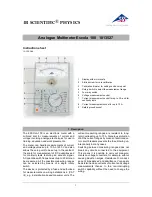
29
Resistance measurement
5.5.
5.5.1.
Connecting the multimeter
5.5.2.
Main measurement
The
multimeter measures resistance (opposition to the flow of current) in ohms (Ω). For this purpose, it sends a
weak current through the measurement leads to the circuit being tested.
The input (+, COM) must not have been overloaded by the accidental application of a voltage on the input
terminals with the switch set to Ω or T°.
-
Selection of range:
automatic or manual
-
"Active" protection:
by PTC thermistor
-
Measurement voltage:
approx. 1.2V
-
Max. open-circuit voltage:
4 V typ.
Because the measurement current of the multimeter takes all possible paths between the probe tips, the resistance
measured in a circuit is often different from the nominal resistance.
The measurement leads can add from 0.1Ω to 0.2Ω of error to resistance measurements. To test the leads, touch the probe
tips together and note the resistance of the leads.
To eliminate the resistance of the leads from the measurement, keep the probe tips together, press the Meas… function key,
then REL, and integrate this measurement as REF.
A MATH secondary measurement is active in resistance measurement.
All measurements made then indicate the resistance between the probe tips.
Ohm
In the 50 M
range, in order to avoid the influence of the mains and guarantee the stated
specifications, it is best to disconnect the multimeter from the Wall Plug to avoid
perturbations.
For measurements greater than 10 M
, a shielded lead is recommended.
For a 2-wire link, use very short wires (<25cm) and twist them together.
Summary of Contents for Metrix MTX 3292B
Page 54: ...54...
Page 55: ...55 X04854A02 Ed 01 02 2019...
















































